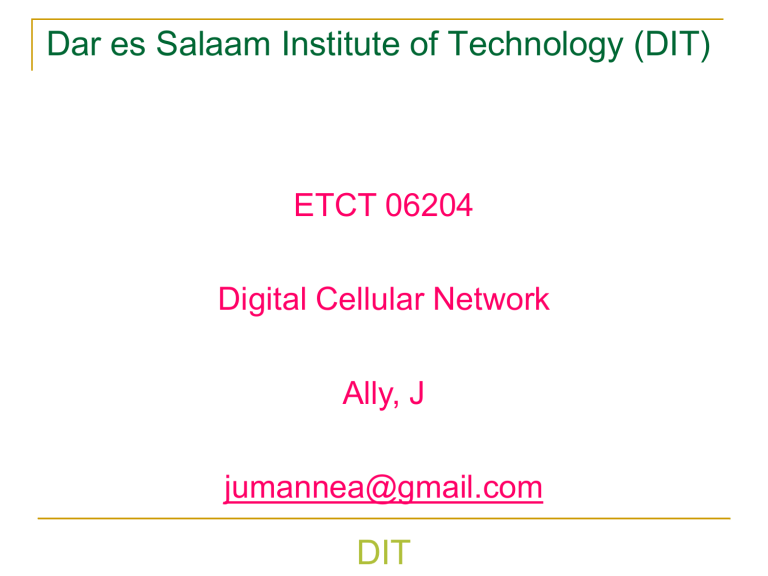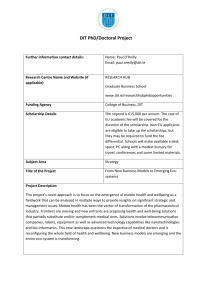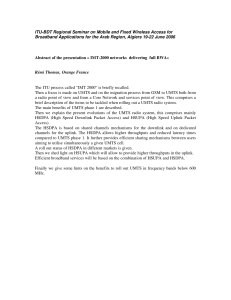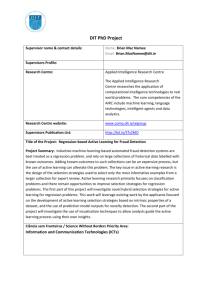
Dar es Salaam Institute of Technology (DIT) ETCT 06204 Digital Cellular Network Ally, J jumannea@gmail.com DIT 3G and 3.5G Networks 3G Evolution ◼ Proposal of 3G ❑ IMT-2000: the general name of third generation mobile communication system ❑ The third generation mobile communication was first proposed in 1985,and was renamed as IMT-2000 in the year of 1996 ◼ ◼ ◼ Commercialization: around the year of 2000 Work band : around 2000MHz The highest service rate :up to 2000Kbps DIT Improvement Beyond Voice Only Core of 3G- CDMA Technology WCDMA Core network: MAP and GPRS-based network Radio transmission technology: WCDMA-FDD/TDD CDMA2000 Core network: ANSI 41 and MIP networktechnology: Radio transmission CDMA2000 3G mechanism TD-SCDMA Core network: MAP-based Radio transmission network technology: TD-SCDMA CDMA technology is the core of 3G. DIT Mobile Multimedia Services by 3G ◼ ◼ ◼ ◼ ◼ ◼ ◼ High-speed packet communication Audio/Visual communication (ex. Video phone) Location service (ex. Navigation) Mobile e-Commerce Multi-call service (Voice+Packet+…) International roaming Contents distribution (Video, Music, Game, Map, etc.) DIT 3G Objectives 3G is developed to achieve: ◼ Universal frequency band for standard and seamless global coverage ◼ High spectral efficiency ◼ High quality of service with complete security and reliability ◼ ◼ Easy and smoothly transition from 2G to 3G, compatible with 2G Provide multimedia services, with the rates: ❑ Vehicle environment: 144kbps ❑ Walking environment: 384kbps ❑ Indoor environment: 2Mbps What is UMTS/WCDMA? An IMT-2000 standard – 3G mobile wireless solution (also known as UMTS/WCDMA) ◼ Compliments GSM/GPRS/EDGE services ◼ High Voice Capacity: ❑ 51 to 83 Erlangs/sector/5 MHz (62 to 95 TCH/sector/5 MHz) ❑ Voice quality rated as excellent ◼ Always On Packet Data Rates: ❑ 384/384kbps (DL/UL) peak data rate in initial (Release 99) commercial deployments ❑ Up to 14.4 Mbps peak downlink data rate with HSDPA (Release 5) ❑ Up to 5.8 Mbps peak Uplink data rate with HSUPA (Release 6) ❑ Evolution to HSPA+ (Release 7) ◼ Up to 28 Mbps downlink peak data rate ◼ Up to 11.5 Mbps uplink peak data rate ❑ Evolution to HSPA+ (Release 8) ◼ Up to 42.2 Mbps downlink peak data rate ◼ Up to 11.5 Mbps uplink peak data rate DIT WCDMA Bands Used ◼ Main bands ❑ ◼ Supplementary bands: different country maybe different ❑ ❑ ❑ ◼ 1920 ~ 1980MHz / 2110 ~ 2170MHz 1850 ~ 1910 MHz / 1930 MHz ~ 1990 MHz (USA) 1710 ~ 1785MHz / 1805 ~ 1880MHz (Japan) 890 ~ 915MHz / 935 ~ 960MHz (Australia) . . . Frequency channel number=central frequency×5, for main band: ❑ ❑ UL frequency channel number :9612~9888 DL frequency channel number : 10562~10838 DIT UMTS (Universal Mobile Telecommunication System) R99 Network Architecture MSC/VLR Other PLMN PSTN,ISDN GMSC GSM /GPRS BSS BSC HLR/AUC BTS PCU SCE SS7 RNC SMS NodeB SCP GPRS backbone UMTS UTRAN Internet, Intranet SGSN GGSN CG BG Other PLMN’s GPRS network DIT UMTS R4 Network Architecture IP/ATM Backbone MGW Other PLMN PSTN,ISDN MGW GSM /GPRS BSS BSC VMSC Server GMSC Server HLR/AUC BTS PCU SCE SS7 RNC SMS NodeB SCP GPRS backbone UMTS UTRAN Internet, Intranet SGSN GGSN CG BG Other PLMN’s GPRS network Page 11 UMTS Elements Definition ◼ ◼ ◼ ◼ ◼ The Mobile Equipment (ME) is the radio terminal used for radio communication over the Uu interface. The UMTS Subscriber Identity Module (USIM) is a smartcard that holds the subscriber identity, performs authentication algorithms, and stores authentication and encryption keys and some subscription information that is needed at the terminal. The Node B converts the data flow between the Iub and Uu interfaces. It also participates in radio resource management. The Radio Network Controller (RNC) owns and controls the radio resources in its domain (the Node Bs connected to it). Home Location Register (HLR) is a database located in the user’s home system that stores the master copy of the user’s service profile. DIT Network Elements Definitions (2) ◼ ◼ ◼ ◼ Mobile Services Switching Centre/Visitor Location Register (MSC/VLR) is the switch (MSC) and database (VLR) that serves the UE in its current location for Circuit-Switched (CS) services. Gateway MSC (GMSC) is the switch at the point where UMTS PLMN is connected to external CS networks. All incoming and outgoing CS connections go through GMSC. Serving General Packet Radio Service (GPRS) Support Node (SGSN) functionality is similar to that of MSC/VLR but is typically used for PacketSwitched (PS) services. Gateway GPRS Support Node (GGSN) functionality is close to that of GMSC but is in relation to PS services. DIT WCDMA Network Architecture DIT WCDMA Network Architecture (2) ◼ WCDMA including the RAN (Radio Access Network) and the CN (Core Network). ❑ ❑ The RAN is used to process all the radio-related functions. The CN is used to process all voice calls and data connections within the UMTS system, and implements the function of external network switching and routing. ◼ Logically, the CN is divided into the CS (Circuit Switched) Domain and the PS (Packet Switched) Domain. ◼ UTRAN, CN and UE (User Equipment) together constitute the whole UMTS system ◼ A RNS (Radio Network Sub-system) is composed of one RNC and one or several Node Bs. ◼ The Iu interface is used between RNC and CN while the Iub interface is adopted between RNC and Node B. DIT WCDMA Network Architecture (3) ◼ Within UTRAN, RNCs connect with one another through the Iur interface. ◼ The Iur interface can connect RNCs via the direct physical connections among them or connect them through the transport network. ◼ RNC is used to allocate and control the radio resources of the connected or related Node B. ◼ Node B serves to convert the data flows between the Iub interface and the Uu interface, and at the same time, it also participates in part of radio resource management. DIT CDMA Concepts – Multiple Access Methods 1-to-1 Frequency Re-Use ◼ ◼ CDMA eliminates frequency planning and achieves higher system capacity. This requires good radio planning, as is true for FDMA/TDMA systems. Common Frequency Channel Power Control Power Control compensates for: - Near/Far Problem - Path Loss - Fading Handover Soft Handover ◼ Soft handover allows the mobile to establish a connection with a new Node B before breaking the connection with the previous serving cell. ◼ In a WCDMA system, a mobile can be “in soft handover” with two or more cells for an extended period of time. This is a desirable state as it provides path diversity. ◼ If the path to one cell experiences a temporary fade, the communication link through the other path or paths may not be affected. Hard Handover ◼ A hard handover occurs when all existing radio links must be dropped before a new link is established. ◼ This causes a brief interruption in voice or data communication, while making the transition from the old serving link to the new. Hard Handover Versus Soft Handover Advantages of Soft Handover ➢ Reduces interference and transmit power required ➢ Increases capacity ➢ Maintains call continuity and reduces dropped calls ➢ Improves voice quality Channel Mapping ◼ In the new WCDMA Access Stratum, radio bearers are mapped onto logical channels, then onto transport channels, and eventually physical channels. UMTS Channels Broadcast Channel ◼ Broadcast Channel (Downlink) ❑ Broadcast Control Channel (BCCH) ❑ Broadcast Channel (BCH) ❑ Primary Common Control Physical Channel (PCCPCH) ❑ First channel to be decoded by UE after acquisition ❑ Carries system information such as system ID, cell ID, neighbor cell information, system frame number, etc. Paging Channel ◼ Paging Channel (Downlink) ❑ ❑ ❑ ❑ ❑ ❑ Paging Control Channel (PCCH) Paging Channel (PCH) Secondary Common Control Physical Channel (SCCPCH) Page Indicator Channel (PICH) Monitored by UE in Idle Mode, CELL_PCH, and URA_PCH Carries Paging messages Random and Forward Access Channels ◼ Random Access Channel (Uplink) Common Control Channel (CCCH) ❑ Random Access Channel (RACH) ❑ Physical Random Access Channel (PRACH) ❑ Transmitted by UE to access the system Forward Access Channel (Downlink) ❑ Common Control Channel (CCCH) ❑ Forward Access Channel (FACH) ❑ Secondary Common Control Physical Channel (SCCPCH) ❑ Acquisition Indication Channel (AICH) ❑ Carries UTRAN messages to UE in Idle mode ❑ ◼ Dedicated Channels ◼ Dedicated Channels (Uplink/Downlink) ❑ ❑ ❑ ❑ ❑ ❑ Dedicated Control Channel (DCCH) Dedicated Traffic Channel (DTCH) Dedicated Channel (DCH) Dedicated Physical Data Channel (DPDCH) Dedicated Physical Control Channel (DPCCH) Carries signaling and user data HSDPA and HSUPA What are the drivers and motivations for HSDPA and HSUPA? ✓Data Rate ➢Demand for high data rate multimedia services ➢Demand for higher peak data rates ✓Throughput/Capacity ➢Cost per megabyte ✓Coverage ➢ Higher data rates available over a larger cell footprint ✓Delay ➢Lower Latency DIT HSDPA (High Speed Downlink Packet Access ) ◼ What is HSDPA? ❑ Enhancement of 3GPP W-CDMA specification ❑ Targeting throughput enhancement and delay reduction ❑ Providing peak data rate up to 14.4 Mbps ◼ Technologies ❑ Use of downlink shared channel ❑ Both QPSK and 16QAM transmission ❑ Adaptive Modulation and Coding (AMC) ❑ Hybrid ARQ (Automatic Repeat request) ❑ Effective packet scheduling algorithm DIT Quadrature Amplitude Modulation 16QAM QPSK i1 i2 10 11 q2 00 10 i2 1011 1001 0001 0011 1010 1000 0000 0010 1110 1100 0100 0110 1111 1101 0101 0111 q1 q2 Same amount of noise 2 bits per symbol Robust 4 bits per symbol Requires high S/N DIT Radio Channel Quality Adaptive Modulation and Coding (AMC) Modulation & Coding Channel Quality Indicator (CQI) QPSK 16 QAM time (mS) Use high level modulation and coding rate when channel condition is good Data Throughput can be increased 05/17/17 DIT Scheduling • In each time slot, the terminals which have good downlink condition are selected. (Multiuser diversity) • Date queue for each terminal is monitored. NodeB schedules the downlink according to the queue length. NodeB MS1 MS2 MS4 MS3 Data Queue at NodeB Balance ➢fairness ➢throughput ➢delay Downlink Scheduling time DIT HSDPA Scheduling and Retransmissions ◼ Scheduling ❑ ❑ ❑ ◼ Done at the Node B No interaction with the RNC Based on Channel Quality Feedback from the UE Retransmissions ❑ ❑ ❑ ❑ H-ARQ (link level retransmissions) Based on UE feedback (ACK/NAK) Done at the Node B Soft combining at the UE DIT HSDPA Channels DIT HSDPA Performance Summary ◼ Maximum Theoretical Data Rate: ❑ 14.4 Mbps ◼ ◼ Practical Peak User Data Rate: ❑ 10.0 Mbps ◼ ◼ ◼ ❑ ◼ Virtually impossible to obtain in the field. Full capability UE Good RF conditions (High Cell Geometry) Single UE Dedicated HSDPA carrier Significant Performance Gains over Release 99 ❑ ❑ Peak Data Rate Cell Throughput DIT HSUPA (High Speed Downlink Packet Access ) ◼ What is HSUPA? ❑ ❑ ❑ ❑ ◼ Enhancement of 3GPP W-CDMA specification Targeting throughput enhancement (Uplink) Providing peak data rate up to 5.76 Mbps Upload of photo/movie, on-site live reporting, etc. Technologies (Similar to HSDPA, under control of NodeB) ❑ ❑ ❑ ❑ ❑ ❑ Use of Uplink shared channel QPSK transmission QAM Rele.7 Adaptive Modulation and Coding (AMC) Hybrid ARQ Effective packet scheduling algorithm DIT HSUPA Channels ◼ HSUPA Uplink Channels Enhanced Uplink Dedicated Channel (E-DCH) ❑ ◼ E-DCH Dedicated Physical Data Channel (E-DPDCH) ❑ ◼ Downlink Physical Channel E-DCH Absolute Grant Channel (E-AGCH) ❑ ◼ Uplink Control Channel HSUPA Downlink Channels E-DCH Hybrid ARQ Indicator Channel (E-HICH) ❑ ◼ Uplink Physical Channel E-DCH Dedicated Physical Control Channel (E-DPCCH) ❑ ◼ Uplink Transport Channel Downlink Physical Channel E-DCH Relative Grant Channel (E-RGCH) ❑ Downlink Physical Channel DIT HSUPA Channel Mapping DIT HSDPA/HSUPA Summary ◼ HSDPA and HSUPA offer Significant Performance Gains over Release 99 ❑ Peak Data Rate ◼ ❑ Cell Throughput ◼ ◼ ❑ Theoretical Maximum: 14.4/5.74 Mbps (Downlink/Uplink) Improved Spectral Efficiency Fast Scheduling and Improved Link Adaptation Delay ◼ Reduced Latency DIT Goals For HSPA+ In Release 7 ◼ Enhancements in Release 7 will enable: ❑ ❑ ❑ ❑ ❑ Reduced latency Higher user throughput Higher system capacity Extended talk time Faster call setup It is important to achieve these goals with minimal changes to software, hardware, and network architecture, ensuring backward compatibility. DIT HSPA+ Advantages ◼ Cost effective upgrade ❑ ◼ Can be selectively deployed in areas with high demand for data and for voice ❑ ❑ ◼ HSPA is being widely deployed. HSPA+ can leverage existing assets: ◼ Cell Sites, UTRAN, and Core Network. Deployment of HSPA+ will provide an edge in terms of time to deploy. Selective deployment based upon needs can be easily achieved. Backward Compatibility ❑ ❑ Backward compatible with existing UTRA. ◼ No dedicated spectrum needed. R99, R5/R6, HSPA, and HSPA+ devices operate on the same network. DIT Evolution of HSPA Maximum Peak Bit Rate DIT DIT





